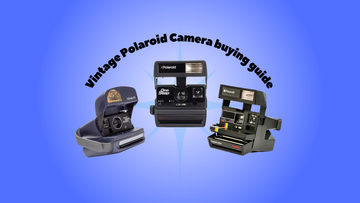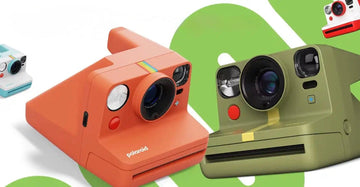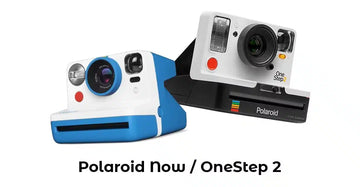Mastering the Art of Vintage Polaroid Photography: A Comprehensive Guide
par Дашка Шипунова sur Jul 29, 2025

Polaroid cameras have long been a beloved icon of analog photography, capturing the hearts and imaginations of photographers and enthusiasts alike. With their distinct aesthetic, instant gratification, and nostalgic charm, these vintage marvels have stood the test of time, remaining a popular choice for those seeking a unique and authentic photographic experience. However, navigating the world of vintage Polaroid cameras can be a daunting task, with a myriad of models, features, and potential pitfalls to consider.
In this comprehensive guide, we'll dive deep into the world of vintage Polaroid 600-type cameras, exploring the key factors to consider when making a purchase, the essential features to look for, and the tips and tricks to ensure you get the most out of your vintage Polaroid experience. Whether you're a seasoned Polaroid enthusiast or a newcomer to the analog photography scene, this article will equip you with the knowledge and confidence to find the perfect vintage Polaroid camera and capture stunning, one-of-a-kind images.
Navigating the Vintage Polaroid Landscape
Polaroid's 600-type cameras, which were produced from the 1980s to the early 2000s, are the focus of this guide. These cameras, with their iconic square format and instantly developing film, have become a staple in the world of analog photography. However, with a wide range of models and variations, it's important to understand the key differences and features to ensure you make an informed purchase.
Autofocus vs. Fixed Focus
One of the primary distinctions among Polaroid 600-type cameras is the focusing mechanism. Polaroid produced both autofocus and fixed-focus models, each with their own advantages and considerations.
- Autofocus Models: These cameras feature a sophisticated autofocus system that uses sonar technology to determine the distance to the subject and adjust the lens accordingly. This allows for a wider range of focusing distances, typically from as close as 60cm (2 feet) to infinity. Autofocus models are often denoted by the "AF" designation in the model name, such as the Polaroid 636 AF.
- Fixed-Focus Models: These cameras have a fixed-focus lens, meaning the focus is set to a specific range, typically from 1.2m (4 feet) to infinity. While this may seem limiting, fixed-focus models can be a great option for those who prefer a simpler, more straightforward shooting experience. Some fixed-focus models, like the Polaroid 600 Close-Up, feature a built-in close-up lens that can be used for subjects between 60cm (2 feet) and 1.2m (4 feet).
When choosing between autofocus and fixed-focus models, consider your shooting style and the types of subjects you'll be photographing. Autofocus models offer more versatility, while fixed-focus models can be a great choice for those who prioritize simplicity and ease of use.
Vintage vs. Modern Designs
Polaroid 600-type cameras also come in a range of design styles, with both vintage and more modern aesthetics. The older, "boxier" models from the 1980s and early 1990s are often favored for their classic, retro look, while the later, more rounded models from the late 1990s and early 2000s tend to be more streamlined and modern in appearance.
While the differences in design may seem purely aesthetic, there can be some practical considerations as well. The older, boxier models are often perceived as more durable and reliable, while the newer, rounded models are generally considered to be a bit more fragile. However, it's important to note that with proper care and maintenance, both vintage and modern Polaroid 600-type cameras can provide reliable and enjoyable photographic experiences.
Essential Features to Look For
When shopping for a vintage Polaroid 600-type camera, there are several key features and specifications to keep an eye out for to ensure you get the most out of your purchase.
Flash Functionality
One of the most important features to consider is the camera's flash functionality. Polaroid 600-type cameras were designed to work in conjunction with the built-in flash, which provides the necessary illumination for indoor and low-light shooting. While there are a few models, such as the Polaroid Amigo, that lack a built-in flash, it's generally recommended to opt for a model that includes this essential feature. The flash not only ensures proper exposure but also contributes to the iconic Polaroid aesthetic, making it a crucial component of the vintage Polaroid experience.
Film Compatibility
Another important factor to consider is the camera's film compatibility. Polaroid 600-type cameras were designed to use the Polaroid 600 instant film format, which is still widely available today. However, it's worth noting that Polaroid ceased production of their own 600 film in 2008, leading to the rise of third-party film manufacturers like Impossible Project (now Polaroid Originals) and Fujifilm. When purchasing a vintage Polaroid camera, be sure to check that it is compatible with the current 600 film offerings, as some older models may not work with certain types of film.
Battery Life and Power Source
Unlike modern digital cameras, vintage Polaroid 600-type cameras rely on the battery power provided by the film pack itself. Each Polaroid 600 film pack contains a built-in battery that powers the camera's functions, including the flash and the film ejection mechanism. When testing a vintage Polaroid camera, it's essential to ensure that the battery in the film pack is still functioning properly, as a dead or weak battery can prevent the camera from operating correctly.
To test the camera's battery life and power source, you can use an empty film pack or a pack with expired film. Simply insert the film pack, close the camera, and observe the camera's behavior. If the camera makes the characteristic whirring and clicking sounds, and the film pack is ejected smoothly, then the battery is likely in good condition. This simple test can help you avoid the disappointment of a non-functioning camera due to a dead battery.
Preparing Your Vintage Polaroid Camera for Use
Once you've acquired your vintage Polaroid 600-type camera, it's important to properly prepare it for use to ensure the best possible photographic results. Here are some essential steps to follow:
Cleaning and Maintenance
Before loading your first film pack, it's a good idea to give your vintage Polaroid camera a thorough cleaning. Use a soft, lint-free cloth to gently wipe down the exterior of the camera, paying special attention to the lens and any moving parts. Avoid using harsh chemicals or abrasives, as these can damage the camera's delicate components.
Additionally, check the camera's rollers, which are responsible for ejecting the film. Ensure that they are free of any debris or residue that could interfere with the film's smooth ejection. A small amount of camera-safe lubricant can help keep the rollers in good working order.
Testing the Camera
As mentioned earlier, testing the camera with an empty film pack or a pack with expired film is a crucial step in ensuring its functionality. This simple test allows you to check the camera's shutter, flash, and film ejection mechanisms without wasting valuable Polaroid film.
To perform the test, simply insert the film pack, close the camera, and observe the camera's behavior. Listen for the characteristic whirring and clicking sounds, and watch as the film pack is ejected. If the camera performs these actions as expected, you can be confident that the essential components are in working order.
Preparing the Film
When you're ready to start shooting with your vintage Polaroid camera, it's important to properly prepare the film pack. Begin by removing the protective dark slide, which is the first piece of film that is ejected when you load a new pack. This slide helps protect the sensitive film from exposure to light during the loading process.
Next, be sure to store the film pack in a cool, dry place until you're ready to use it. Exposure to heat and humidity can negatively impact the film's performance and lifespan. When you're ready to shoot, simply insert the film pack into the camera, close the door, and you're ready to start capturing those iconic Polaroid moments.
Mastering Vintage Polaroid Photography
With your vintage Polaroid 600-type camera properly prepared and ready to go, it's time to dive into the art of vintage Polaroid photography. While the process may seem straightforward, there are a few techniques and considerations to keep in mind to get the most out of your Polaroid experience.
Composition and Framing
One of the unique challenges of Polaroid photography is the square format. Unlike the more common 35mm or digital camera aspect ratios, the Polaroid's square frame requires a different approach to composition and framing. Embrace the constraints of the format and experiment with creative compositions that make the most of the square shape.
Consider using the frame's edges to your advantage, placing your subject off-center or using negative space to create a sense of balance and tension. The square format also lends itself well to portraiture, allowing you to capture your subjects in a more intimate and focused way.
Lighting and Exposure
Proper lighting and exposure are crucial when working with Polaroid film. The camera's built-in flash can be a valuable tool, but it's important to use it judiciously. The flash can be overpowering in close-up shots or in small, enclosed spaces, leading to harsh shadows and blown-out highlights.
When possible, try to take advantage of natural lighting, whether it's from a window, outdoors, or a well-lit indoor space. This will help you achieve a more balanced and natural-looking exposure. If you do need to use the flash, experiment with different distances and angles to find the sweet spot that complements your subject and the scene.
Experimentation and Creativity
One of the joys of working with vintage Polaroid cameras is the element of surprise and unpredictability. The unique characteristics of Polaroid film, such as its sensitivity to temperature and light, can lead to unexpected and often delightful results. Embrace this sense of experimentation and don't be afraid to try new techniques and approaches.
Consider double exposures, where you expose the same frame twice to create surreal and dreamlike images. You can also experiment with in-camera manipulation, such as shaking the film pack during development or applying various materials and textures to the surface of the print.
Remember, the beauty of Polaroid photography lies in its imperfections and the sense of spontaneity it evokes. Approach each shot with an open mind and a willingness to be surprised by the results.
Caring for Your Vintage Polaroid Camera
Owning a vintage Polaroid 600-type camera is a labor of love, and proper care and maintenance are essential to ensuring its longevity and continued performance. Here are some tips to help you keep your Polaroid camera in top condition:
Proper Storage and Transport
When not in use, store your vintage Polaroid camera in a cool, dry place, away from direct sunlight and extreme temperatures. Avoid storing the camera in humid environments, as this can lead to mold and mildew growth, which can damage the camera's internal components.
When transporting your Polaroid camera, be sure to handle it with care and avoid subjecting it to sudden impacts or vibrations. Consider using a padded camera bag or case to protect the camera during travel.
Regular Cleaning and Maintenance
As mentioned earlier, regular cleaning and maintenance are crucial for the longevity of your vintage Polaroid camera. Gently wipe down the exterior with a soft, lint-free cloth, and use a camera-safe cleaning solution to remove any stubborn dirt or residue.
Pay special attention to the camera's rollers, which can become clogged with dried film residue over time. Carefully clean these rollers using a soft, damp cloth or a small amount of camera-safe lubricant. Avoid using harsh chemicals or abrasives, as these can damage the delicate components.
Sourcing Replacement Parts
As vintage Polaroid cameras age, it's not uncommon for certain parts to wear out or become damaged. If you encounter any issues with your camera, it's important to source replacement parts from reputable suppliers. Companies like Polaroid Originals and specialized camera repair shops often offer a range of replacement parts and accessories for vintage Polaroid models.
By following these care and maintenance tips, you can help ensure that your vintage Polaroid camera continues to provide you with years of reliable and enjoyable photographic experiences.
Conclusion
Navigating the world of vintage Polaroid 600-type cameras can be a thrilling and rewarding journey for photographers of all skill levels. By understanding the key features, essential considerations, and proper care and maintenance techniques, you can confidently select the perfect vintage Polaroid camera and unlock the magic of instant film photography.
Whether you're drawn to the classic, retro aesthetic of the older models or the streamlined design of the more modern variants, there's a vintage Polaroid camera out there that will capture your unique photographic vision. Embrace the element of surprise, experiment with creative techniques, and let the timeless charm of Polaroid photography inspire you to create truly one-of-a-kind images.
So, what are you waiting for? Dive into the world of vintage Polaroid photography and let the magic of instant film transport you to a bygone era of analog wonder. Happy shooting!




